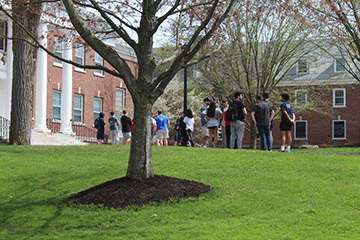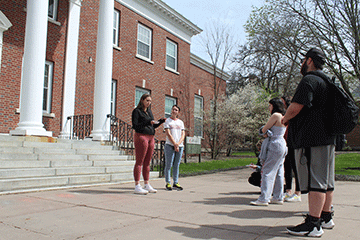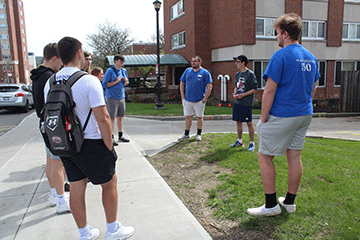
05/02/2022
SUNY Cortland is haunted by stories about ghosts that inhabit its buildings. These tales and legends have earned it a place among the 13 most haunted college campuses in New York state.
Observers have reported a shadowy semblance of an injured football player, titled “the Gridiron ghost,” who allegedly appears in Room 716 of Clark Hall, a student residence.
Campus legend also tells of a sad former cook who materializes and then vanishes on a staircase in Brockway Hall, and “Elizabeth,” a student apparition who was supposedly killed by her boyfriend in Cheney Hall during the 1980s.
But it’s not Peter Venkman and the Ghostbusters who are trying to get to the bottom of the scary tales that have evolved among successive generations of Red Dragons.

It’s a group of SUNY Cortland history students.
On May 5 — in bright daylight rather than spooky darkness — the Introduction to Public History class at SUNY Cortland gave a walking tour of all the campus buildings where legend has it that ghosts have appeared.
“We might not realize it, but every ghost story has a history,” said Associate Professor Evan Faulkenbury, who teaches the class.
“Even if you don’t believe in ghosts — and I’m one — ghost stories can reveal the way people in the past held attitudes, beliefs and values. The popular ghost stories that get passed between students at SUNY Cortland, for example, can tell us about what students cared about on campus going back to the 1980s.”

The tour leaders — Emma Efing, Luke Barrett, Nick Bateson, Harrison Finnerty, Josh Halvorsen and Tori Ruliffson — began the tour at 3 p.m. with an introduction on the lawn in front of Cheney Hall, one of six buildings that contribute to SUNY Cortland’s reputation as a haunted campus. From there, the tour separated into three groups and walked to Brockway Hall, Clark Hall, Corey Union and Van Hoesen Hall to hear from the students about each building’s haunted oral history. The tour ended around 4 p.m.
It is the first time a SUNY Cortland class has thought of digging through the archives to find hard facts about ephemeral spirits. They’ve been preparing for the tour for half the semester, Faulkenbury said.
According to him, the real-life influences behind shadowy apparitions was a worthy topic for his 35-member class, which focused on how scholars interpret human curiosity about manifestations of the afterlife.
“I wanted to emphasize that this project isn’t about whether or not these ghost stories are true, but rather, ‘What’s the actual history and background that gave rise to these ghost stories on campus?’” Faulkenbury said. “We’re using primary sources to get at this history, not rumors or pseudoscience.”
After carefully researching each ethereal “sighting” in campus archives housed in Memorial Library, the class made two big observations, tour guides noted. First, these incidents couldn’t be traced back to factual records, such as police records of murder or suicide, and even some locations were sketchy. For example, there’s no actual Room 716 in Clark Hall where the “Gridiron ghost” could lurk.
“The fact that these stories such as the Clark Hall ghost all happened at about the same time, we believe, is too big a coincidence for us to overlook completely and not think that there is some co-relation,” said one of the tour guides, Emma Efing, a sophomore dual major in social studies education and history from LeRoy, N.Y.
Yet the stories of haunted halls occurred around the same period of the 1980s. This was about the time when the campus opened the VOICE Office in Corey Union, where diverse campus community members could express their concerns. And the counseling center, currently housed in Van Hoesen Hall, shifted from serving as an academic remediation center to offering students emotional support.
The class concluded that, although any direct link between the supposed hauntings and the campus reaction have been lost in history, the campus community responded to all these reports of supernatural visions by assisting any students who might be struggling with mental health issues or as survivors of sexual assault or violence in a relationship.
For that reason, the tour wrapped up in front of those very offices still helping students overcome life’s very real barriers today.
“Although the project started out as finding out whether these stories were real or not, and how they grew up on campus, this project turned into finding out how these ghost stories helped the campus become more inclusive and more aware of sexual abuse and mental health issues on campus,” Efing said.
It’s possible the students’ research findings could become part of the university’s permanent history, Faulkenbury said.
Jeremy Pekarek, the university’s archivist and instructional services librarian, first proposed the idea for Faulkenbury’s students to use the archives to examine testimonies of campus paranormal activity.
“The research has been great so far,” said Pekarek, who attended the tour. “The students have been making appointments, being very professional, dealing with material objects in the collection with care. So I’m glad they’re using the archives for experiential learning.”
The walking tour used a weblink to a free digital app called Clio that participants could download and follow on their smartphones. The class also set up an Instagram account for The Haunted Dragon project followers.
For those who missed the tour or want to learn more about the project, the class has installed an exhibit case on the second floor of Old Main in the History Department hallway.